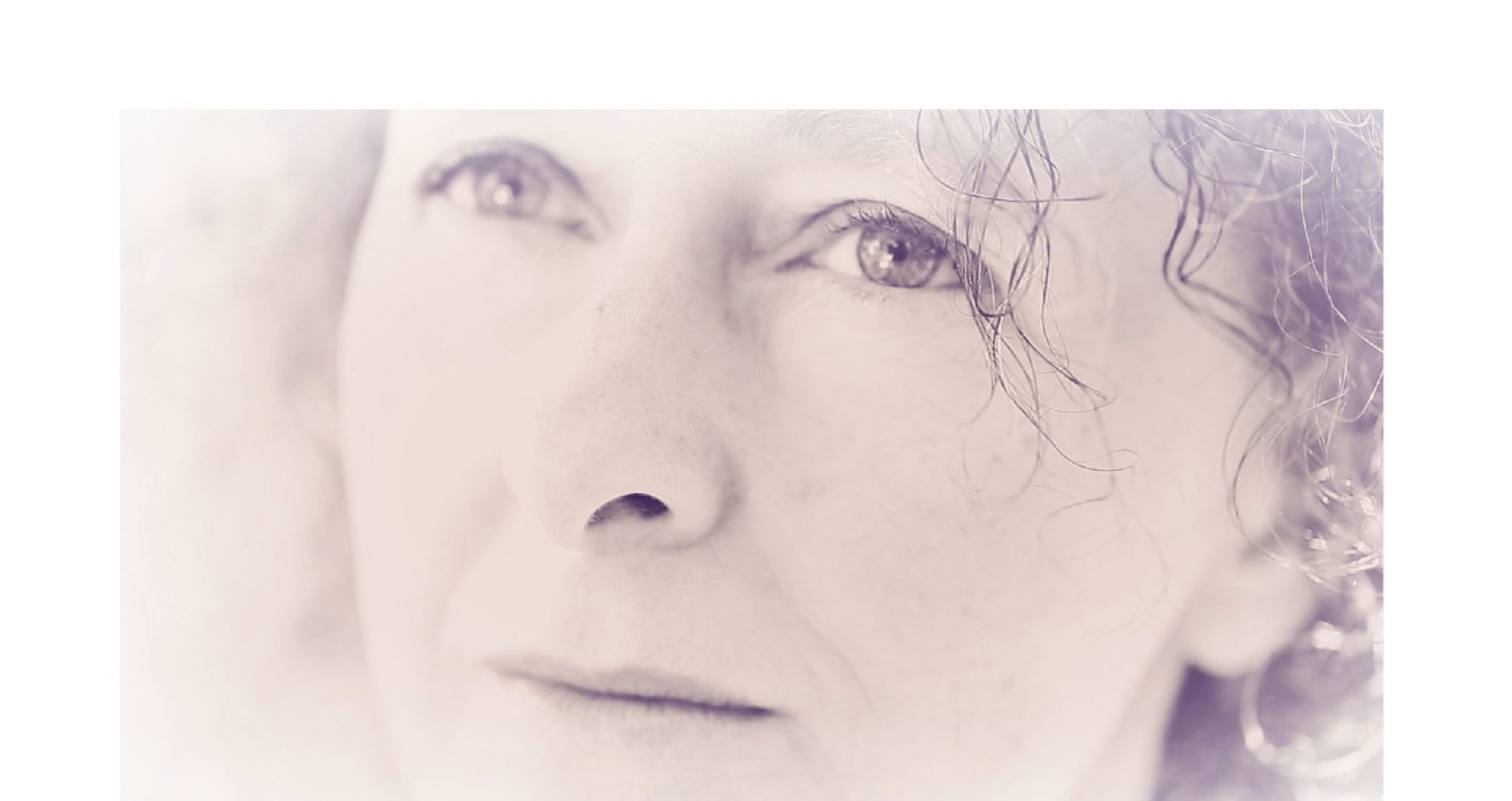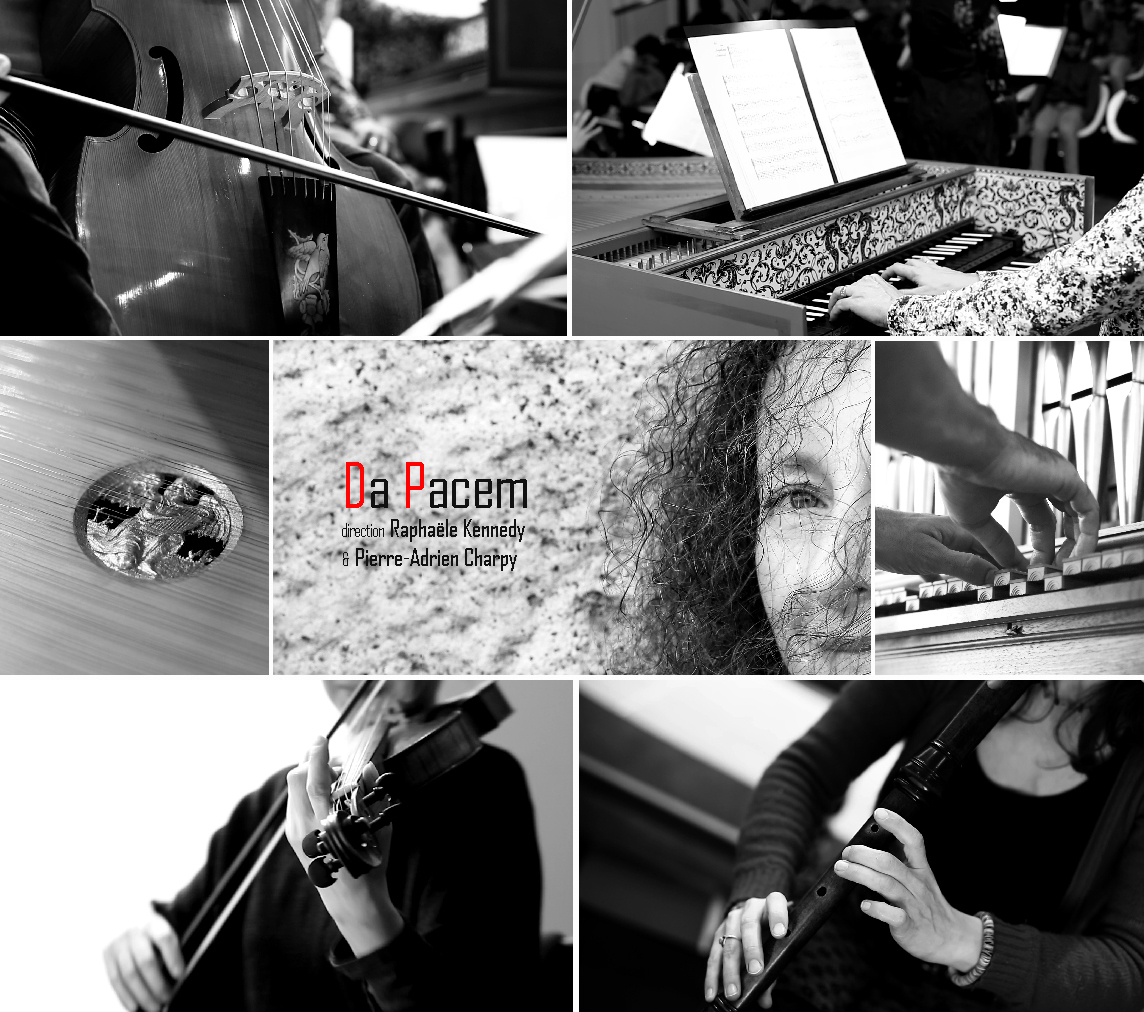
All soloists, the musicians of DA PACEM master with equal ease the repertoire of early music on period instruments and that of contemporary creation on modern instruments and new technologies.
From the end of the Renaissance to the Baroque era, their historical requirements are articulated around thematic projects, imagining a dramaturgy specific to each concert, in a great diversity of timbres and moods. The Italian-style organ, custom-made by Quentin Blumenroeder, contributes to the richness of the continuo, which serves as a showcase for the voices.
Soprano Raphaële Kennedy and composer Pierre-Adrien Charpy, founders of the ensemble in 1998, have also established it as a laboratory for contemporary musical research and dialogue with musicians from both the popular and learned oral traditions.
Neither mixing of genres, nor crossbreeding, nor crossover, their approach privileges the true meeting and confrontation, with rigor and sensitivity.
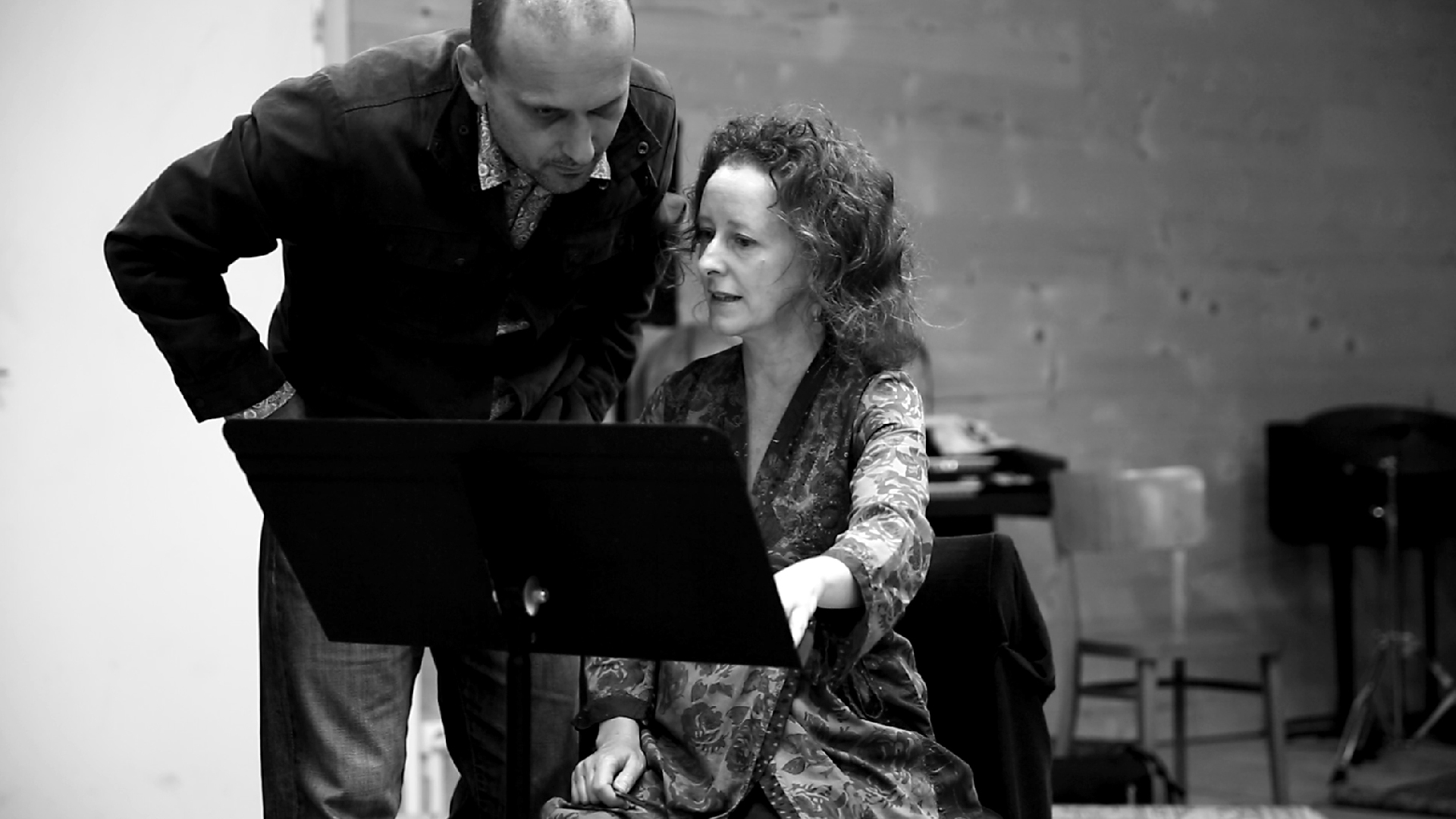
Musicians
Raphaële Kennedy, Vincent Bouchot, Anne Magouët, Isabelle Deproit, Geoffroy Buffière | voices
Virginie Descharmes, Stéphanie Paulet | violin
Marine Sablonnière | recorder
Sylvie Moquet, Marianne Muller | viol
Julien Lucchi | sackbutt
Claire Antonini, Marc Wolff, André Henrich | theorbo, archilute
Yannick Varlet, Jean-Luc Ho | harpsichord
Pierre-Adrien Charpy | organ
Camilla Hoitenga | flute
Serge Bertocchi | saxophone
Marylise Florid | guitar
Thomas Keck | electric guitar
Valérie Dulac | cello
Anaïs Gaudemard | harp
Jean-Jacques Bédikian, Anne Etienvre | piano
VOCAL ENSEMBLE
- TENEBRAE FACTAE SUNT
Music by Tomás Luis de Victoria
Raphaële Kennedy, Anne Magouët, Isabelle Deproit, Vincent Bouchot, Geoffroy Buffière | voices
Pierre-Adrien Charpy | organ
The pieces of the Officium Hebdomadae Sanctae by Tomás Luis de Victoria were part of a complex and very long set of offices. Rather than a liturgical reconstruction or a re-contextualization of this repertoire, we offer the quintessence of this repertoire with the nine Tenebrae Lessons and the eighteen Responsories of Holy Week, a total of twenty-seven pieces unanimously considered as one of the greatest masterpieces of sacred music.
VOICE & INSTRUMENTS
- AU SECOURS MA RAISON
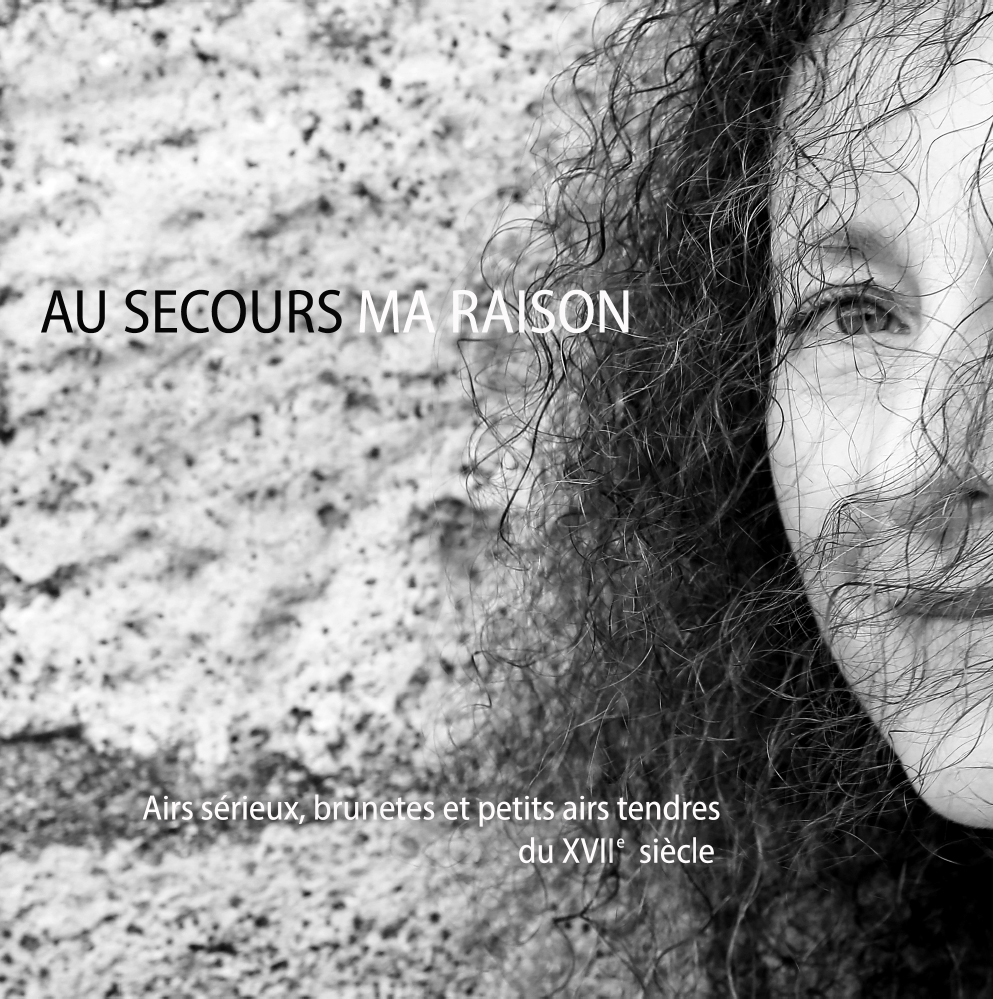
Raphaële Kennedy | voice
Sylvie Moquet | viol
Claire Antonini | theorbo
Yannick Varlet | harpsichord
Happiness to love and to be loved: such is the quest of the one who, by his or her winning attractions, deploys all his or her energy to sigh, to please, to have the advantage, to win the heart, to love tenderly, to cherish sometimes in ardor and sometimes in sweetness, always in constancy. In these airs sérieux, brunetes or petits airs tendres and chansons pour danser of the second half of the XVIIth century, the feelings are jostled: anger, shame, pity, pains and troubles echo to the torment, to the confusion. While the reproaches fly in an extreme sorrow or languor, the forces in action exceed the reason which one calls with the assistance.
- HENRY PURCELL – FACES OF WOMEN
Raphaële Kennedy | voice
Sylvie Moquet | viol
Marc Wolff | theorbo
Yannick Varlet | harpsichord
Pierre-Adrien Charpy | organ
All the women who inhabit the poetry of Henry Purcell’s songs are so many contrasting images. In the collections Orpheus Britannicus and Harmonia sacra – excerpts from which are the subject of this program – we find the absent, disdainful, cruel beloved, the lover herself in love, the future queen, the Goddess, the Virgin. Purcell pays tribute to each of them in turn with the genius that we know of him.
Henry Purcell
The sparrow and the gentle dove (live)
Raphaële Kennedy shows great skill and profound affinity with this style of music. […] She brings the full depth of feeling to these different atmospheres. It is poetry itself, she distils grace and makes us dream.
L’impartial, Denise de Ceuninck, 2005We were charmed by the perfect match between the soprano and Purcell’s music. The musicians delighted soul and imagination, while the soloist hovered above them in an almost way. It was a unique, magical moment.
La liberté, TD., 2005The soprano gave her many-sided, flexible voice to all these women […]. She evolves in clear arabesques, lives and modulates her texts with perfect diction.
La Provence, G.L., 2007In addition to displaying the beauty and natural elasticity of a well-placed voice, this young woman, […] brings a beautiful consistency to each of these works, achieving a rich and brilliant palette of feelings. Her task is rendered all the more easy by a solid continuo quartet who glorify Purcell’s scores.
La Marseillaise, Michel Egéa, 2007It is a voice with contrasting inflexions, alternately sensual, cheerful, celestial, moving, which is well served by the instrumentalists.
Marseille l’hebdo, M.-J.L., 2007
- AMOROUS DISARRAY
Italian music of the 17th century
Raphaële Kennedy | voice
Sylvie Moquet | viol
Marc Wolff | theorbo
Yannick Varlet | harpsichord
Pierre-Adrien Charpy | organ
At the turning point between the 16th and 17th centuries, the notion of music in the image of the harmony of the spheres was progressively abandoned in favour of a musical art which was a vector of the expression of the passions of the human soul. Of all these passions, by far the greatest centre of concern to the poets was love; and as it would not have been seemly to boast of a happy love, amorous disarray was deconstructed in all its forms.
Claudio Monteverdi
Si dolce è’l tormento (live)
- A MUSICAL ALCHEMY : DIETRICH BUXTEHUDE
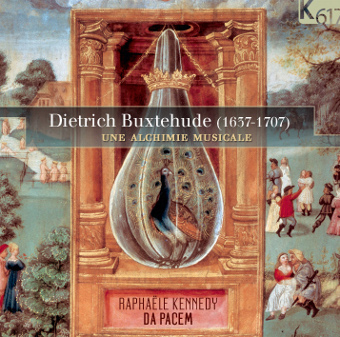
Raphaële Kennedy | voice
Virginie Descharmes, Stéphanie Paulet | violon
Sylvie Moquet | viol
Marc Wolff | theorbo
Yannick Varlet | harpsichord
Pierre-Adrien Charpy | organ
Who can resist the pleasure of exploring the universe of this wonderful composer? He was a true middleman between different musical styles and periods, who achieved a staggering synthesis of the polyphonic, numerical and rhetorical traditions of his predecessors with a very personal poetry, by building musical structures of hitherto unknown richness, all embellished with great tenderness, taking care to make his music accessible to everyone, from the specialist to the layman. It is not surprising that Bach took him as his model!
Dietrich Buxtehude
O dulcis Jesu (extract from CD Une alchimie musicale)
A perfect musical alchemy. […] The performers have not spared their talents, which are numerous. Raphaële Kennedy’s timbre, diaphanous and ethereal, knows how to embody herself in vibrant accents. […] This soprano has a deep sense of declamation which is marvelous here in this music which is permanently based on the text.
Utmisol, Hubert Stoecklin, 2011[…] The soprano Raphaële Kennedy is an exact accomplice of the Buxtehudian piety. […] [She] knows how to stimulate the power of words from within, both Latin and German motets. However, to the accuracy of her expressiveness is added virtuosity, not conquering and sure of its effects, but concerned with touching, rather than pleasing. This is the most fervent portrait of this outstanding creator […].
Classica, Roger Tellard, 2011Buxtehude transmuted. […] In these pieces, Raphaële Kennedy’s timbre and phrasing are marvelous: her sometimes ethereal voice and unaffected singing have just the right amount of human character to give sacred laments, with a final Klag-lied, in other words, a lamentation, which she unfolds with emotion like a painful litany that would never end.
Musikzen, Gérard Pangon, 2011In the service of superb opuses to be discovered, [the instrumentalists] create a subtle, intimate and poetic universe to support and dialogue with the very beautiful timbre of the soprano, suave, airy and perfectly controlled.
Zibeline, Frédéric Isoletta, 2011This was the first time I’d heard soprano Raphaële Kennedy and I was immediately impressed by her clear, present voice, which sparkles in the high notes and displays all its brilliance while always being in tune with the Christian humility of these religious texts.
Radio Südwestrundfunk, Doris Blaich, 2011
- O BEATA VIRGO
Italian marian music of the 17th century
Raphaële Kennedy | voice
André Henrich | theorbo
Yannick Varlet | harpsichord
Pierre-Adrien Charpy | organ
« Who is she who shines like the dawn when it appears? … Fair as the moon, clear as the sun, she brings abundant joy to earth, heaven and seas alike. »
Tarquinio Merula
Canzonetta spirituale sopra alla nanna (extract from 2-CD box set Sillages)
- ECSTASY, SPLENDOUR AND PENITENCE
French sacred music of the 17th– 18th centuries
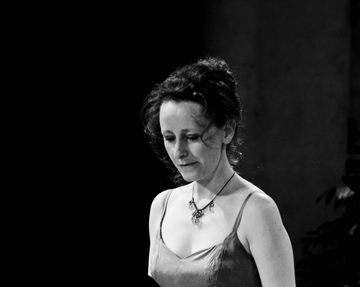
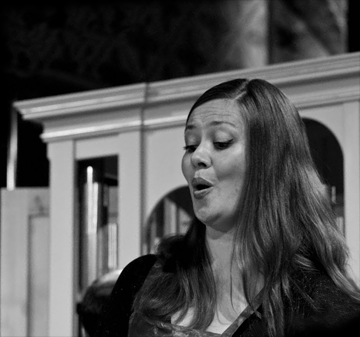
Raphaële Kennedy, Anne Magouët | voices
Sylvie Moquet | viol
Marc Wolff | archlute
Yannick Varlet | harpsichord
Pierre-Adrien Charpy | organ
At the height of the baroque period, Versailles represented the high point of French classical art and culture. Under the influence of the Counter-Reformation, the Jesuits and Madame de Maintenon sacred art reigned supreme. If in this « Grand siècle » penitence was still one of the foundations of catholicism, two other characteristics emerged in religious practice : splendour – the exaltation of the power of God, of his ministers or of the monarch of divine right – and ecstasy – the expression of the sensual mysticism of Saint Theresa of Avila or of Saint John of the Cross. This choice of petits motets shows off the richness of this trinity of religious expression.
Daniel Danielis
Adore te mea salus (live extract)
The audience experienced an exceptional musical moment. Ecstasy, splendor and penitence […] were masterfully transmitted to the audience. Raphaële Kennedy’s pure and limpid voice blends with Anne Magouët’s powerful and ample voice in the same sensuality. The diction is quick and fluid but all in roundness. And sometimes time seems to stop to leave room only for the unique spirituality, as in these answers in distant echo of the motet of Danielis.
L’Eclaireur du Gâtinais et du Centre, B. M.-R., 2010The audience is offered a spiritual journey […]. Just listen and the cult of beauty, the nature of the sacred, the humility of the human condition, the inclination towards the divine burst forth, sublimated by the excellence of the performers. The marvelous range of the voices arouses shivers and emotions. The audience follows, troubled, enthusiastic, amazed.
Le Dauphiné Libéré, Christine Barbier, 2010
- ELEGANCE AND INSOLENCE AT THE COURT OF CHARLES IX
Music by Guillaume Costeley, Guillaume Boni, Anthoine de Bertrand, Claude Lejeune
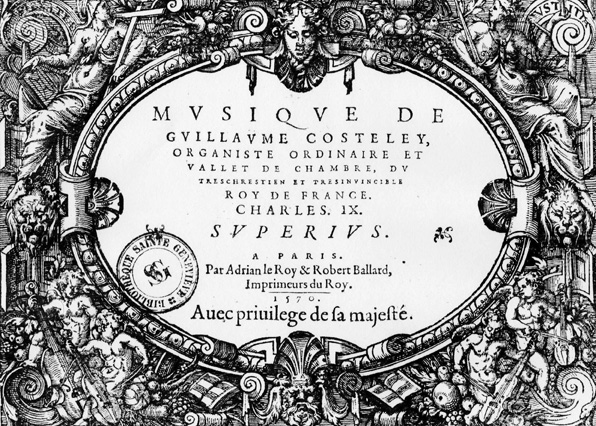
Raphaële Kennedy, Vincent Bouchot | voices
Marine Sablonnière | flutes
Sylvie Moquet | viol
Julien Lucchi | sackbut
Pierre-Adrien Charpy | organ
Great men embodied the ideal of the humanist civilization of the Renaissance. Sensitive to this preoccupation, certain kings of France gave their approval to some literary men and musicians among other great minds; it is the case of Charles IX, educated prince and cultivator of letters. In a preface addressed to this one, Ronsard writes for the biggest happiness of the musicians: « Celui, Sire, lequel oyant un doux accord d’instruments ou la douceur de la voix naturelle ne s’en réjouit point, ne s’en émeut point et de tête en pieds n’en tressaut point, comme doucement ravi, et si ne sais comment dérobé de soi : c’est signe qu’il a l’âme tortue, vicieuse et dépravée ».
It is a repertoire of great variety that flows to the ear: from the superb melody Je suis déshéritée by Claude Lejeune, interpreted with infinite suavity by Raphaële Kennedy, to the strange chromatic songs or songs measured in the antique style by the same composer, avant-garde for his time. […] It is the texts of Pierre de Ronsard that we taste […]. A whole refined universe that rubs shoulders with the saucy… and some frankly naughty texts! Vincent Bouchot puts them in his mouth and tenorizes with a visible pleasure to send back his rabelaisian line to his soprano partner… just as truculent!
Zibeline, Jacques Freschel, 2015
- ULYSSES IN THE FEMININE
French cantatas of the 18th century
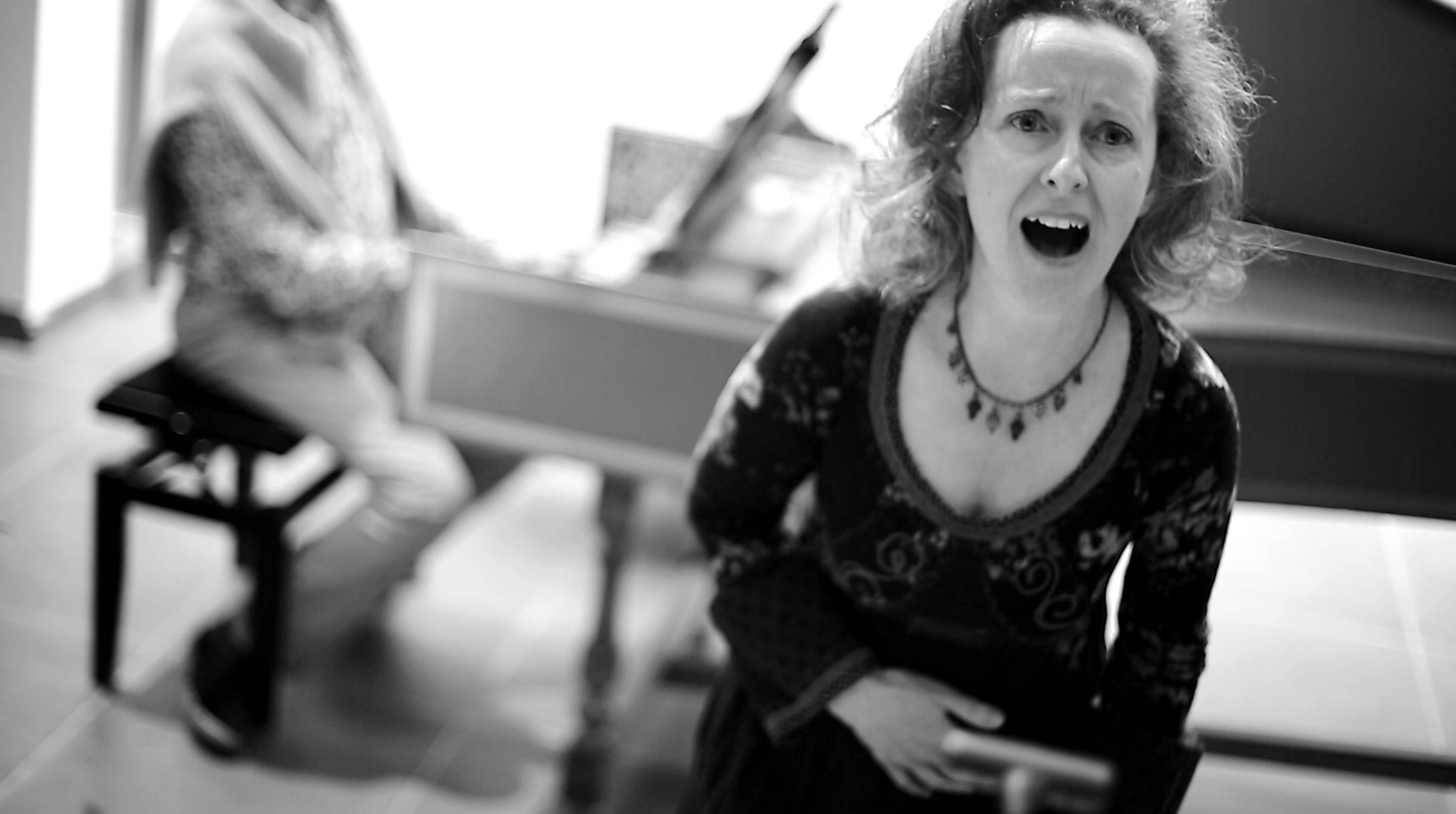
Raphaële Kennedy | voice
Stéphanie Paulet | violin
Marine Sablonnière | flute
Marianne Muller | viol
Yannick Varlet | harpsichord
Ulysses in the feminine is a water story. Musical, poetic, symbolic […]. And by water, we mean not so much mirrors as tides, rocks and storms, the fury of the elements in the restrained setting of a French concert. Alternating cantatas and instrumental pieces […], the program combines spoken evocations, constituting, over and above the succession of concert pieces, a vast new chamber opera with recitatives that would tell the story of the works and days of a feminine Ulysses – that is to say, precisely of the women who make and unmake Ulysses throughout his Odyssey, restoring the hero’s feminine part and justifying the grammatical genre of his adventure. They are numerous, […] – loving, tempestuous, dangerous, faithful or nurturing, they say as much if not more than the sweat and leather on the hero’s fabric.
Didier Lamare
Elisabeth Jacquet de la Guerre
Le Sommeil d’Ulisse (extrait live)
In order to define Raphaële Kennedy’s voice in this program, we would like to dare to use the word « liquidity » – if it had not taken on this awful market value. A satiny, ductile soprano, sometimes moiré like the cloths brought to the hero on his return to his homeland, a Persian voice like Athena’s eyes […]. One would like to know what one has heard of these stories of water, tides and storms. The slack in the perfect unison of the violin and the flute, one slipping into the wake of the other, inventing a rare sonic jewel whose attacks and holding are neither those of the bow, nor those of the breath – but something else that perhaps has to do with the spirit of the voice. The ample or turbulent backwash of the basso continuo, the virtuoso complicity of the viol and the harpsichord, constantly drawing, with a gesture that is ephemeral each time, new paths on which to place the song.
Demi-cadratin.fr, Didier Lamare, 2016
- LEÇONS DE TÉNÈBRES BY NICOLAS BERNIER
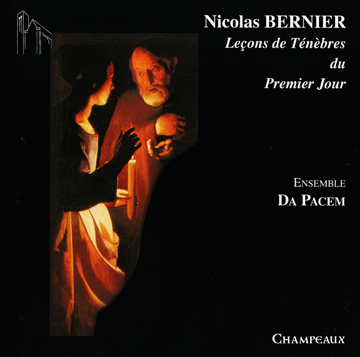
Raphaële Kennedy | voice
Sylvie Moquet | viol
Pierre-Adrien Charpy | organ
Plain-song
Nicolas Bernier is incontestably one of the most remarkable figures in French music at the beginning of the 18th century. His Tenebrae Lessons hold a special place in his output : apart from the fact that none of them were published, they are the expression of a typically french art from the pen of a deliberately italianist composer.
Nicolas Bernier
1ère leçon de Ténèbres du premier jour (extract from CD Leçons de Ténèbres du premier jour)
The performance of the Leçons deserves nothing but the highest of praise. Raphaële Kennedy’s voice is solid, supple, attentive to the least inflexion of the musical text, and in perfect complicity with the continuo. Her timbre is at once clear, homogenous and warm.
Répertoire, Michel Lamalle, 1998Raphaële Kennedy’s sweet, clear voice is full of grace and delicacy. […] Everything contributes to an atmosphere of ecstasy
Classica, Stéphan Perreau, 1998The devotional character revealed by soprano Raphaële Kennedy is prodigious in its simplicity : without artifice and with total disregard of herself, she communicates suffering, sadness and doubt with these « musical lamentations » which touch the heart and truly reach the mark. […] An exaltation that intoxicates and delights<
Crescendo, Noël Godts, 1998Raphaële Kennedy shows herself to be completely at home in this music, and faultless in her precision […].
Diapason, Jean-luc Macia, 1998
- TO OUR ANCESTORS, TO OUR CHILDREN
Collaboration between Pierre-Adrien Charpy and Moussa Héma, a traditional balafonist from Burkina-Faso
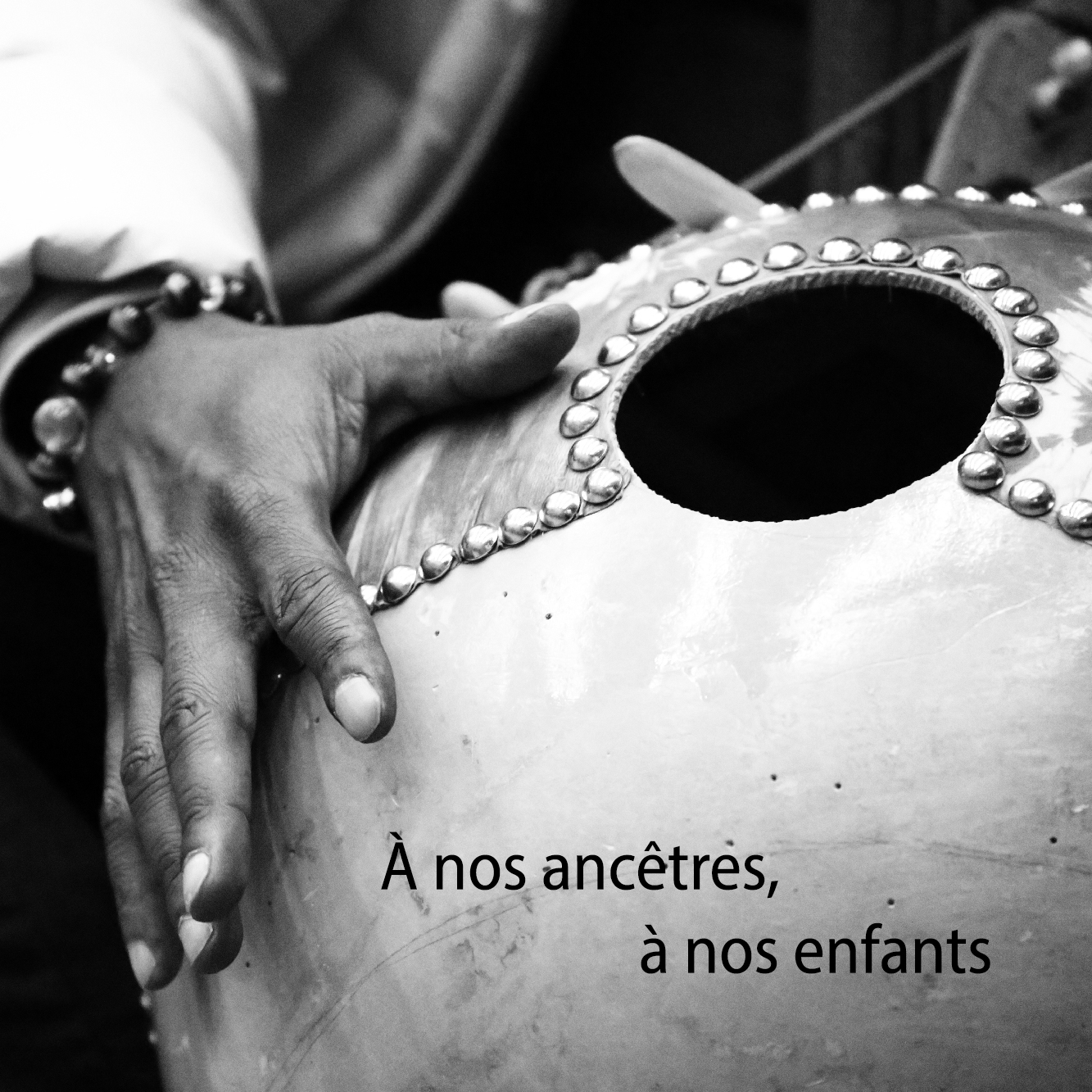
Raphaële Kennedy | voice
Moussa Héma | balafon, n’goni, voice
Sylvie Moquet | viol
Yannick Varlet | harpsichord
Pierre-Adrien Charpy | organ
I wanted this encounter with the Burkinabe balafonist Moussa Héma to reach a form of joy and jubilation from the sometimes troubled depths of beings and history. Could we open up traditions, eras and styles to each other, with energy and health, without compromising their identity? This piece is for me an encounter with the other, as well as with oneself, at the most intimate level.
Pierre-Adrien Charpy
This very long piece is not actually a piece, no more than it is a fully written composition : it is a meeting between musicians. […] Between the initiatory voice of Raphaële Kennedy, the chromatic instruments of the ensemble Da Pacem […] and Moussa Héma’s pentatonic instruments : the « young man’s » n’goni, the balafon made of African bar-wood, his singing in the Dyula language which honours the most enduring of the African cults, expressing reverence for the ancestors and promise to the children. It is a weird baroque symphony […]. It is a concert – in the etymological sense. […] a work of mutual respect; it’s all about welcoming and giving.
Didier Lamare
Pierre-Adrien Charpy / Moussa Héma
Danse (extrait coffret 2 CD Sillages)
The sound of the balafon is full of laughter and phantoms, the wind of the organ and the grain of the harpsichord make rain fall on the fertility dance, the viol sings the deep roots of the tree and the rapids of the river. According to how much faith we have in the future the soprano voice hovers in a sunset over red ruins or like the white light of the bird flying away from the tree. Between the Europe and Africa of yesterday and today, À nos ancêtres, à nos enfants is a concert of transmission, a music aspiring to human brotherhood.
Didier Lamare, 2017The concert had a title that was a program, a moving respect for the elders and a tender tribute to the children. Turning to the past and looking to the future, it made of an old music and a new music, both timeless, supported by a traditional African music, a magnificent harmony in act, a beautiful present, a superb gift.
Classiquenews.com, Benito Pelegrín, 2011
- MOTETS FOR ONE AND TWO VOICES BY ANDRÉ CAMPRA
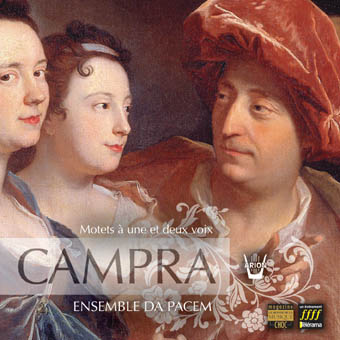
Raphaële Kennedy, Claire Lefilliâtre | voices
Virginie Descharmes | violin
Pierre-Adrien Charpy | organ
André Campra is a federator of French and Italian styles, even in his smallest motets. He is a man of jubilant vocalisations, subtle harmonies, colourful orchestration and refined melodies. In his Apologie de la musique française, Laugier summed up perfectly in 1754, the soul of this outstanding figure of the French 18th century: « Lalande is an artist who is held in higher esteem, Campra is a seducer who is infinitely loved ».
Stéphan Perreau
André Campra
Salve Regina (extract from CD Motets à une et deux voix)
The two young soloists […] compete with each other in grace and inspiration : the purity of vocal emission, the beauty of the vocalises, the expressive intensity and precision […].
Le Monde de la Musique, Philippe Venturini, 2000[…] the performers […] present this music with perfect taste…
Télérama, Xavier Lacavalerie, 2000Raphaële Kennedy joins up with the talents of Claire Lefilliâtre to create a real emotional whirlwind.
Classica, Coralie Welcomme, 2000Both singers have beautiful voices […]. Raphaële Kennedy’s tone is […] perfect, and her subtle use of vibrato adds a bit of spice to the music, without getting in its way.
Classical Music Web, Kirk McElhearn
VOICE & ELECTRONICS
- À ELLE-MÊME RÉVÉLÉE
Music by Pierre-Adrien Charpy, Robert Pascal, Kaija Saariaho, Adrien Sassier
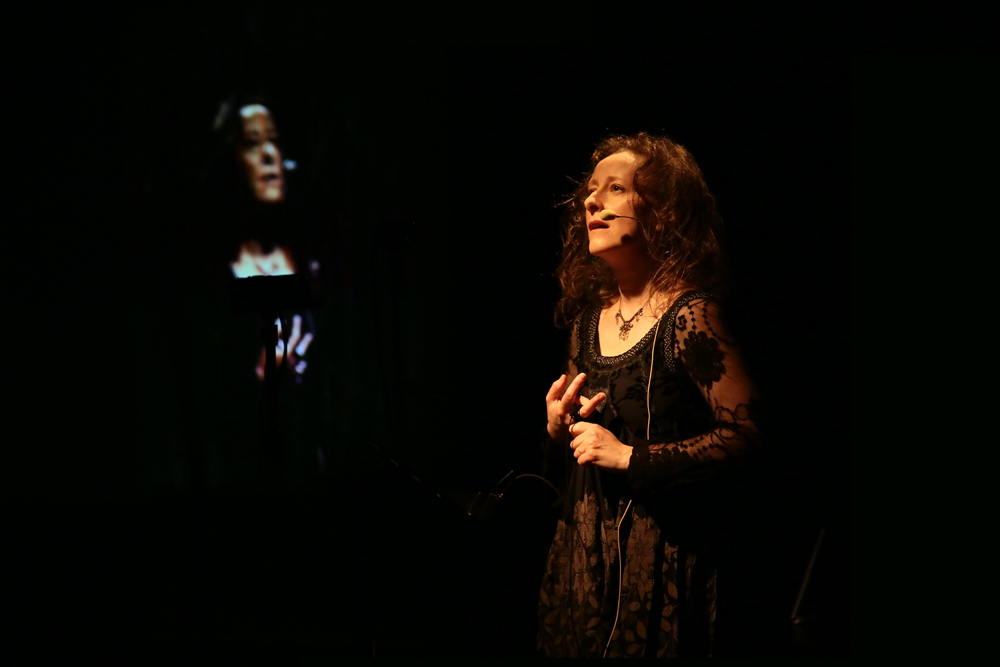
Do we have any idea of how much a singer is alone in such a program, despite the most considerable orchestras, with infinite numbers of musicians, with limitless timbres? Alone, undoubtedly, but not absolutely. […] it is above all a question of the relative uniqueness of the voice passed through « real time electronic processing ». The expression, inelegant, still smells a bit like a geek, but it doesn’t mean anything more esoteric than a new way of opening and populating the musical spaces that are being dug around the voice. Voice doubled, redoubled, taken in the echo, accompanied, followed, anticipated or caught up by these other voices which inhabit us without us being really conscious of it until a composer, precisely, reveals them.
Didier Lamare
Pierre-Adrien Charpy
Vivante morte éblouie (extract from 2-CD box set Sillages)
Robert Pascal
xī lǐng (extract from CD Aubes)
Raphaële Kennedy’s voice would be […] of the crystal, of the translucent, of the brilliance that emerges on the angle of the word. A crystal where colors would pass, elusive, as in these stained glass windows of today that are melted at a very high temperature; yes, it would be something of that order, a fusing voice, virtuoso without showiness, a crystal of flesh, an incarnated transparency. Because it is not enough, as a crystal beats in the electronics, to sing phonemes by using all the means of expression which make the language sound […]. It is also necessary, at the same time and with the same requirement, to draw from it the flesh and the blood, the palpitation of the meaning, to give us the taste of it in order to transmit the emotion of it. This is exactly what happens on both sides of the electronic mirror, a small miracle renewed at every moment by the intertwining of the fixed voice and the living voice.
Demi-cadratin.fr, Didier Lamare, may 2015Vivante morte éblouie, two paragraphs of Belle du Seigneur by Albert Cohen where the swell rolls on the electronic waves illuminated by the luminous foam of the voice of Raphaële Kennedy, a near and far dream strike […].
Le blog-note de Benito on radio dialogue RCF, Benito Pelegrín, 2017[…] xī lǐng (2012), a spectacular Chinese-style landscape, snow-capped peaks, a boat on a lake and birds in the sky, for soprano and electroacoustic device, with the porcelain voice of Raphaële Kennedy.
L.L., november 2023
- ÉCRIRE LA NUIT
Music by Kaija Saariaho, Philippe Leroux, Loïse Bulot
In this program with eclectic texts, the voice carries the desire of the artists to write the night, their night. The astral music of Loïse Bulot leads into the dream. It accompanies Emily Dickinson for whom darkness is always necessary and liberating; it responds to the inner world of Kaija Saariaho and to the ethereal love lived beyond the distance of the troubadour Jaufré Rudel; it opposes the dynamic sound gestures of Philippe Leroux and the burning expression of darkness and light of Edmond Jabès.
A singer is never so alone on stage as in pieces with electronics, which paradoxically diapers her voice with unheard-of magic. Sought after by today’s composers, Raphaële Kennedy has made a speciality of it, with a requirement comparable to that of her interpretations of Renaissance polyphonies and baroque court arias. On the program for this nocturne: […] Lonh, by Kaija Saariaho, one of the masterpieces of the genre, of which Raphaële Kennedy has become the privileged interpreter.
L.L., december 2018
TOGETHER WITH YANNICK VARLET | Organ
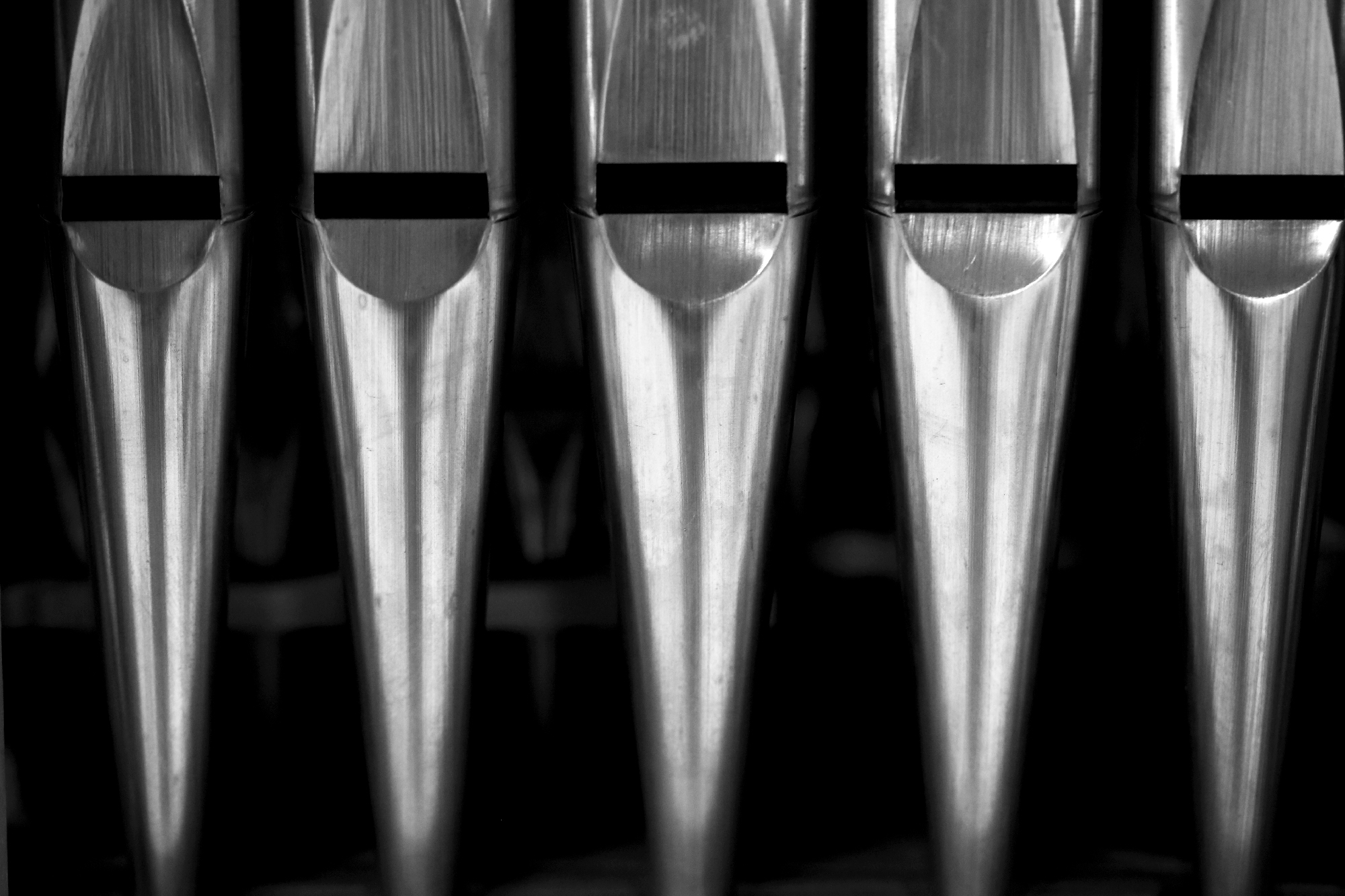
- O BEATA VIRGO
Music by Claudio Monteverdi, Alessandro Grandi, Giovanni Felice Sances, Bonifacio Graziani
Who is she who shines like the dawn when it appears? … Fair as the moon, clear as the sun, she brings abundant joy to earth, heaven and seas alike. »
- GOTT, EILE ZU MIR
Music by Heinrich Schütz, Dietrich Buxtehude, Johann-Christoph Bach
In the 17th century it was said that Italy sang, France danced and Germany prayed. The output of German composers of this period is marked by this deep piety.
- VENI IN HORTUM MEUM
French music of the 17th century
The music illustrating this program is based directly on the universal and unique text of the Bible, the Song of Songs. Attributed to the great King Solomon, the sage among the sages, this great love poem contains the double meaning of human love and mystical love.
TOGETHER WITH JEAN-LUC HO | Harpsichord
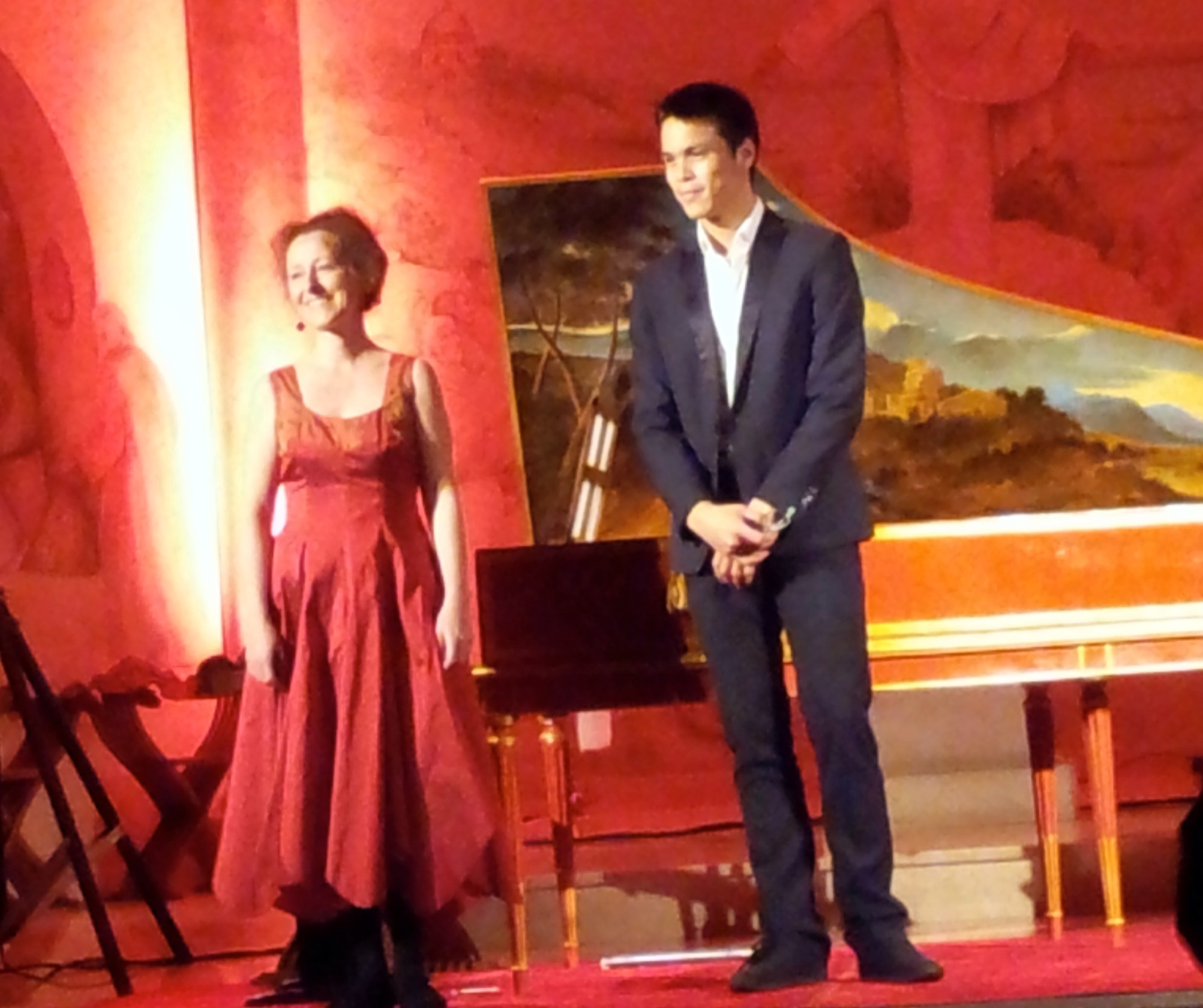
- FACES OF WOMEN IN PURCELL’S SONGS
All the women who inhabit the poetry of Henry Purcell’s songs are so many contrasting images. In the collections Orpheus Britannicus and Harmonia sacra – excerpts from which are the subject of this program – we find the absent, disdainful, cruel beloved, the lover herself in love, the future queen, the Goddess, the Virgin. Purcell pays tribute to each of them in turn with the genius that we know of him.
- SANCES AND VALENTINI, ITALIAN COMPOSERS IN THE COURT OF VIENNA
TOGETHER WITH MARYLISE FLORID | Guitar
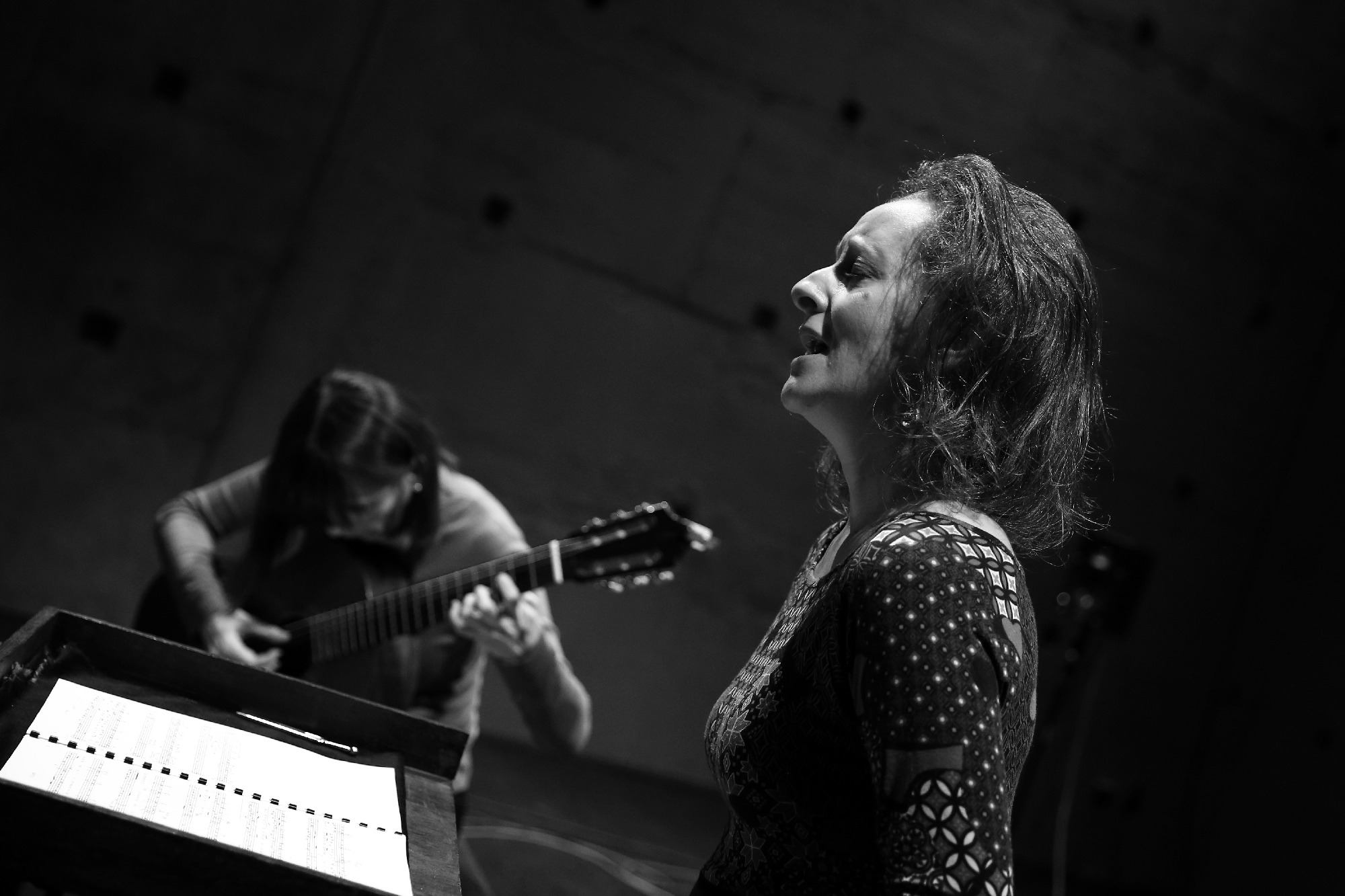
- SOLEILS
Texts and Music by Federico Garcia-Lorca, Manuel De Falla, Enrique Granados, Heitor Villa-Lobos, Andrée Chédid, Pierre-Adrien Charpy
By sublimating the natural phenomenon of alternating temporal suns, this contrasted, personified poetry and music depicts two interior, emotional suns. The first is the symbol of day, of life, of action, of passions, of extreme and exalted feelings, whilst the second is that of nocturnal rest, of contemplation, of nostalgic and melancholy sentiments.
Federico Garcia-Lorca
Canciones españolas antiguas (live extract)
Pierre-Adrien Charpy
Ce corps (extract from 2-CD box set Sillages)
[…] one hears every aspect and nuance of the word in the voice. Its melancholy interior and its light, its power to carve by making frozen breastplates flow red, but also the breath which brings it to life, the soft fragility of felt : one can also hear the body in a state of permanent tension, each word of the poem being brought out by the counterpoint of the guitar.
Didier Lamare, 2017
TOGETHER WITH CAMILLA HOITENGA | Flutes

- AIMONS!
Music by Patrick Burgan, Pierre-Adrien Charpy, William Brooks, Kaija Saariaho
Complicity, energy, playfulness, poetry, work on the texture offered by the flute and the intertwined voices are the assets that we develop in the existing repertoire as well as in the creations.
Patrick Burgan
Jeux de femmes (live extract)
Camilla Hoitenga, flutist and Raphaële Kennedy, soprano, black lace, pale pink satin, announced the color: it would be a sensual and vibrant exchange. […] Camilla Hoitenga plays with brio. […] Raphaële Kennedy, a specialist in early music, masters all the technical and expressive difficulties: soaring high notes, pianissimi, spoken sounds, strange and magical. […] A vibrant tribute to contemporary music with the oldest of instruments: the breath!
Zibeline, Yves Bergé, december 2009
TOGETHER WITH ANNE ETIENVRE | Piano
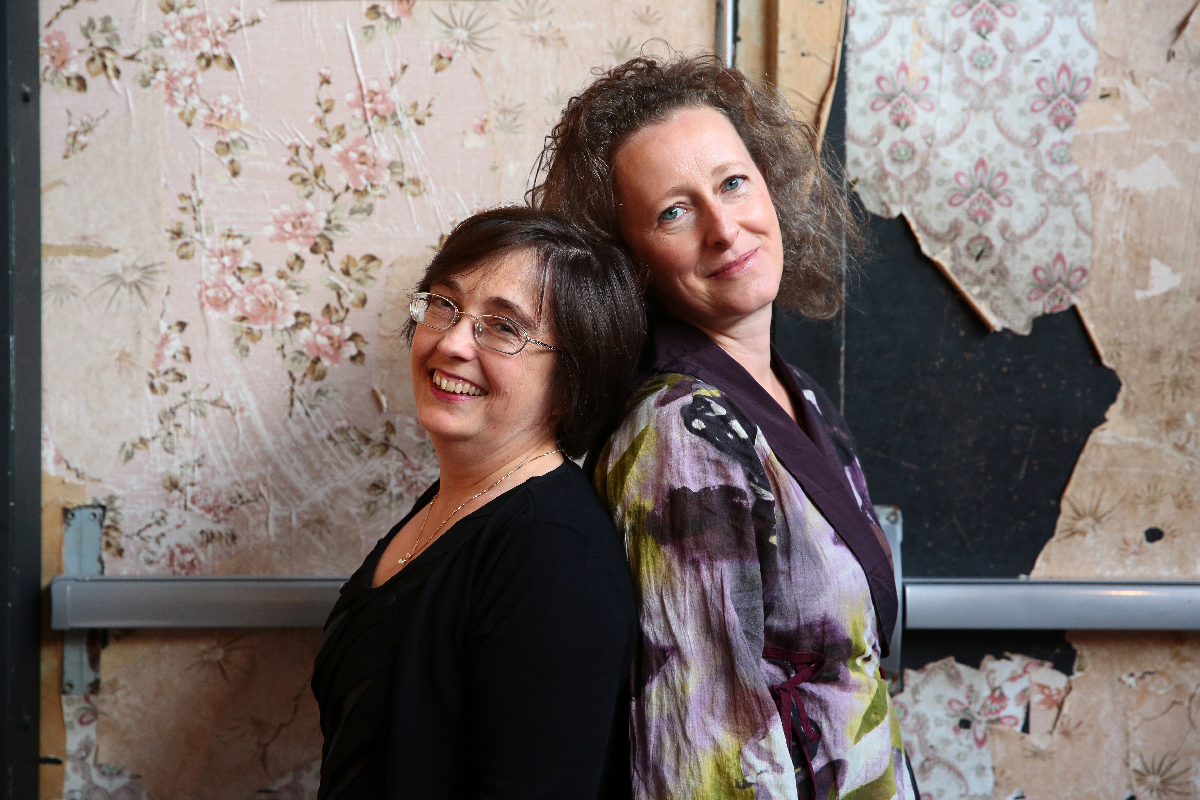
- ALANGUIES OU FANTASQUES?
French melodies and songs by Claude Debussy, Gabriel Fauré, Francis Poulenc, Vincent Bouchot, Pierre-Adrien Charpy
Pierre-Adrien Charpy
Le coeur du poète (live extract)
Photos credits:
Da Pacem©Isabelle Françaix
Pierre-Adrien Charpy and Raphaële Kennedy©Isabelle Françaix
Au secours ma raison©Isabelle Françaix
Raphaële Kennedy and Anne Magouët©Alain Anselm
Raphaële Kennedy in Ulysse au féminin©Isabelle Françaix
À nos ancêtres, à nos enfants©Isabelle Françaix
Orgue Quentin Blumenroeder©Isabelle Françaix
Marylise Florid et Raphaële Kennedy©Isabelle Françaix
Anne Etienvre et Raphaële Kennedy©Isabelle Françaix
